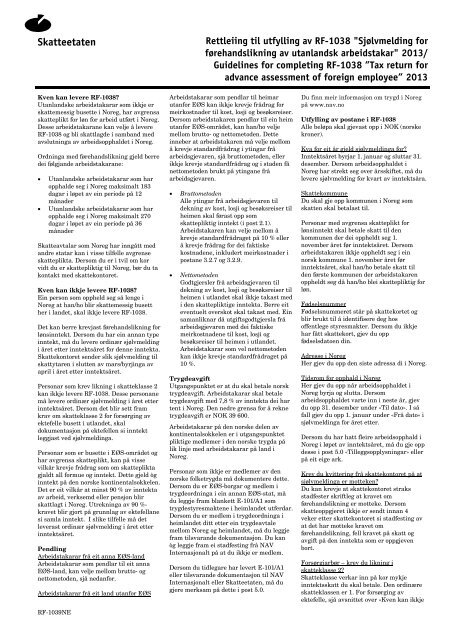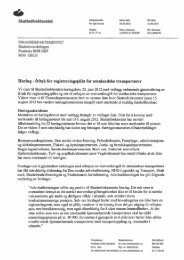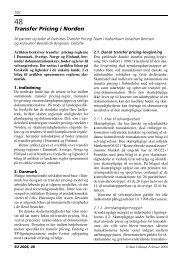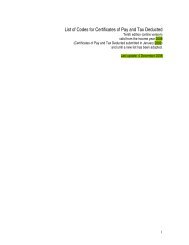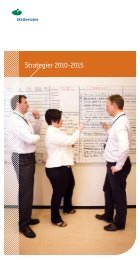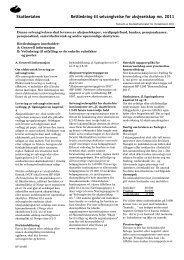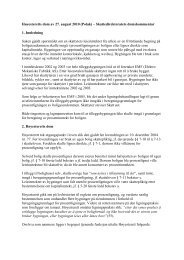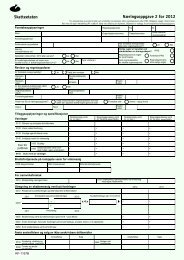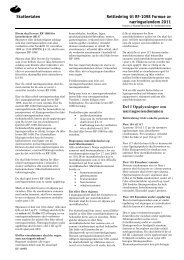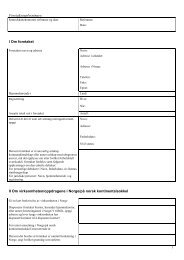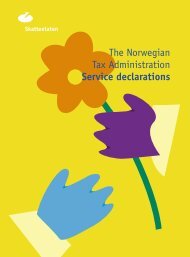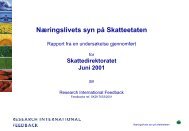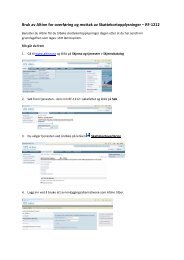Skatteetaten
Skatteetaten
Skatteetaten
You also want an ePaper? Increase the reach of your titles
YUMPU automatically turns print PDFs into web optimized ePapers that Google loves.
<strong>Skatteetaten</strong><br />
Rettleiing til utfylling av RF-1038 "Sjølvmelding for<br />
førehandslikning av utanlandsk arbeidstakar" 2013/<br />
Guidelines for completing RF-1038 ”Tax return for<br />
advance assessment of foreign employee” 2013<br />
Kven kan levere RF-1038?<br />
Utanlandske arbeidstakarar som ikkje er<br />
skattemessig busette i Noreg, har avgrensa<br />
skatteplikt for løn for arbeid utført i Noreg.<br />
Desse arbeidstakarane kan velje å levere<br />
RF-1038 og bli skattlagde i samband med<br />
avslutninga av arbeidsopphaldet i Noreg.<br />
Ordninga med førehandslikning gjeld berre<br />
dei følgjande arbeidstakarane:<br />
<br />
<br />
Utanlandske arbeidstakarar som har<br />
opphalde seg i Noreg maksimalt 183<br />
dagar i løpet av ein periode på 12<br />
månader<br />
Utanlandske arbeidstakarar som har<br />
opphalde seg i Noreg maksimalt 270<br />
dagar i løpet av ein periode på 36<br />
månader<br />
Skatteavtalar som Noreg har inngått med<br />
andre statar kan i visse tilfelle avgrense<br />
skatteplikta. Dersom du er i tvil om kor<br />
vidt du er skattepliktig til Noreg, bør du ta<br />
kontakt med skattekontoret.<br />
Kven kan ikkje levere RF-1038?<br />
Ein person som oppheld seg så lenge i<br />
Noreg at han/ho blir skattemessig busett<br />
her i landet, skal ikkje levere RF-1038.<br />
Det kan berre krevjast førehandslikning for<br />
lønsinntekt. Dersom du har ein annan type<br />
inntekt, må du levere ordinær sjølvmelding<br />
i året etter inntektsåret for denne inntekta.<br />
Skattekontoret sender slik sjølvmelding til<br />
skattytaren i slutten av mars/byrjinga av<br />
april i året etter inntektsåret.<br />
Personar som krev likning i skatteklasse 2<br />
kan ikkje levere RF-1038. Desse personane<br />
må levere ordinær sjølvmelding i året etter<br />
inntektsåret. Dersom det blir sett fram<br />
krav om skatteklasse 2 for forsørging av<br />
ektefelle busett i utlandet, skal<br />
dokumentasjon på ektefellen si inntekt<br />
leggjast ved sjølvmeldinga.<br />
Personar som er busette i EØS-området og<br />
har avgrensa skatteplikt, kan på visse<br />
vilkår krevje frådrag som om skatteplikta<br />
gjaldt all formue og inntekt. Dette gjeld òg<br />
inntekt på den norske kontinentalsokkelen.<br />
Det er eit vilkår at minst 90 % av inntekta<br />
av arbeid, verksemd eller pensjon blir<br />
skattlagt i Noreg. Utrekninga av 90 %-<br />
kravet blir gjort på grunnlag av ektefellane<br />
si samla inntekt. I slike tilfelle må det<br />
leverast ordinær sjølvmelding i året etter<br />
inntektsåret.<br />
Pendling<br />
Arbeidstakarar frå eit anna EØS-land<br />
Arbeidstakarar som pendlar til eit anna<br />
EØS-land, kan velje mellom brutto- og<br />
nettometoden, sjå nedanfor.<br />
Arbeidstakarar frå eit land utanfor EØS<br />
RF-1039NE<br />
Arbeidstakarar som pendlar til heimar<br />
utanfor EØS kan ikkje krevje frådrag for<br />
meirkostnader til kost, losji og besøksreiser.<br />
Dersom arbeidstakaren pendlar til ein heim<br />
utanfor EØS-området, kan han/ho velje<br />
mellom brutto- og nettometoden. Dette<br />
inneber at arbeidstakaren må velje mellom<br />
å krevje standardfrådrag i ytingar frå<br />
arbeidsgjevaren, sjå bruttometoden, eller<br />
ikkje krevje standardfrådrag og i staden få<br />
nettometoden brukt på ytingane frå<br />
arbeidsgjevaren.<br />
<br />
<br />
Bruttometoden<br />
Alle ytingar frå arbeidsgjevaren til<br />
dekning av kost, losji og besøksreiser til<br />
heimen skal førast opp som<br />
skattepliktig inntekt (i post 2.1).<br />
Arbeidstakaren kan velje mellom å<br />
krevje standardfrådraget på 10 % eller<br />
å krevje frådrag for dei faktiske<br />
kostnadene, inkludert meirkostnader i<br />
postane 3.2.7 og 3.2.9.<br />
Nettometoden<br />
Godtgjersler frå arbeidsgjevaren til<br />
dekning av kost, losji og besøksreiser til<br />
heimen i utlandet skal ikkje takast med<br />
i den skattepliktige inntekta. Berre eit<br />
eventuelt overskot skal takast med. Ein<br />
samanliknar då utgiftsgodtgjersla frå<br />
arbeidsgjevaren med dei faktiske<br />
meirkostnadene til kost, losji og<br />
besøksreiser til heimen i utlandet.<br />
Arbeidstakarar som vel nettometoden<br />
kan ikkje krevje standardfrådraget på<br />
10 %.<br />
Trygdeavgift<br />
Utgangspunktet er at du skal betale norsk<br />
trygdeavgift. Arbeidstakarar skal betale<br />
trygdeavgift med 7,8 % av inntekta dei har<br />
tent i Noreg. Den nedre grensa for å rekne<br />
trygdeavgift er NOK 39 600.<br />
Arbeidstakarar på den norske delen av<br />
kontinentalsokkelen er i utgangspunktet<br />
pliktige medlemer i den norske trygda på<br />
lik linje med arbeidstakarar på land i<br />
Noreg.<br />
Personar som ikkje er medlemer av den<br />
norske folketrygda må dokumentere dette.<br />
Dersom du er EØS-borgar og medlem i<br />
trygdeordninga i ein annan EØS-stat, må<br />
du leggje fram blankett E-101/A1 som<br />
trygdestyresmaktene i heimlandet utferdar.<br />
Dersom du er medlem i trygdeordninga i<br />
heimlandet ditt etter ein trygdeavtale<br />
mellom Noreg og heimlandet, må du leggje<br />
fram tilsvarande dokumentasjon. Du kan<br />
òg leggje fram ei stadfesting frå NAV<br />
Internasjonalt på at du ikkje er medlem.<br />
Dersom du tidlegare har levert E-101/A1<br />
eller tilsvarande dokumentasjon til NAV<br />
Internasjonalt eller <strong>Skatteetaten</strong>, må du<br />
gjere merksam på dette i post 5.0.<br />
Du finn meir informasjon om trygd i Noreg<br />
på www.nav.no<br />
Utfylling av postane i RF-1038<br />
Alle beløpa skal gjevast opp i NOK (norske<br />
kroner).<br />
Kva for eit år gjeld sjølvmeldinga for?<br />
Inntektsåret byrjar 1. januar og sluttar 31.<br />
desember. Dersom arbeidsopphaldet i<br />
Noreg har strekt seg over årsskiftet, må du<br />
levere sjølvmelding for kvart av inntektsåra.<br />
Skattekommune<br />
Du skal gje opp kommunen i Noreg som<br />
skatten skal betalast til.<br />
Personar med avgrensa skatteplikt for<br />
lønsinntekt skal betale skatt til den<br />
kommunen der dei oppheldt seg 1.<br />
november året før inntektsåret. Dersom<br />
arbeidstakaren ikkje oppheldt seg i ein<br />
norsk kommune 1. november året før<br />
inntektsåret, skal han/ho betale skatt til<br />
den første kommunen der arbeidstakaren<br />
oppheldt seg då han/ho blei skattepliktig for<br />
løn.<br />
Fødselsnummer<br />
Fødselsnummeret står på skattekortet og<br />
blir brukt til å identifisere deg hos<br />
offentlege styresmakter. Dersom du ikkje<br />
har fått skattekort, gjev du opp<br />
fødselsdatoen din.<br />
Adresse i Noreg<br />
Her gjev du opp den siste adressa di i Noreg.<br />
Tidsrom for opphald i Noreg<br />
Her gjev du opp når arbeidsopphaldet i<br />
Noreg byrja og slutta. Dersom<br />
arbeidsopphaldet varte inn i neste år, gjev<br />
du opp 31. desember under «Til dato». I så<br />
fall gjev du opp 1. januar under «Frå dato» i<br />
sjølvmeldinga for året etter.<br />
Dersom du har hatt fleire arbeidsopphald i<br />
Noreg i løpet av inntektsåret, må du gje opp<br />
desse i post 5.0 «Tilleggsopplysningar» eller<br />
på eit eige ark.<br />
Krev du kvittering frå skattekontoret på at<br />
sjølvmeldinga er motteken?<br />
Du kan krevje at skattekontoret straks<br />
stadfester skriftleg at kravet om<br />
førehandslikning er motteke. Dersom<br />
skatteoppgjeret ikkje er sendt innan 4<br />
veker etter skattekontoret si stadfesting av<br />
at det har motteke kravet om<br />
førehandslikning, fell kravet på skatt og<br />
avgift på den inntekta som er oppgjeven<br />
bort.<br />
Forsørgjarbør – krev du likning i<br />
skatteklasse 2?<br />
Skatteklasse verkar inn på kor mykje<br />
inntektsskatt du skal betale. Den ordinære<br />
skatteklassen er 1. For forsørging av<br />
ektefelle, sjå avsnittet over «Kven kan ikkje
levere RF-1038?». Einslege personar som<br />
åleine har omsorg for barn som er 17 år<br />
eller yngre, eller er åleine om den faktiske<br />
forsørginga av barn som er 18 år eller eldre,<br />
kan òg krevje skatteklasse 2. Dette må i så<br />
fall dokumenterast.<br />
Skattekontoret kan rettleie deg dersom du<br />
er i tvil om du kan krevje likning i<br />
skatteklasse 2 eller ikkje.<br />
2.1 Løn, godtgjersler, naturalytingar o.a.<br />
opptent i Noreg<br />
Her fører du løn, honorar, feriepengar og<br />
andre ytingar frå arbeidsgjevaren. Ein au<br />
pair skal reknast for å vere ein<br />
arbeidstakar, og ytingar som au pairar<br />
mottek under arbeidsopphaldet i Noreg er<br />
skattepliktige.<br />
Fordel av fri kost er skattepliktig. Dei<br />
fastsette satsane (NOK per døgn) er:<br />
Fordel/år 2012 2013<br />
Fri kost – alle måltid 79 80<br />
Fri kost – 2 måltid 62 63<br />
Fri kost – 1 måltid 41 41<br />
Sjå avsnittet over om «Pendling» for<br />
informasjon om når fordelen av fritt losji og<br />
frie besøksreiser til heimen i utlandet skal<br />
gjevast opp i post 2.1.<br />
Løn og anna arbeidsvederlag frå ein<br />
einskild arbeids- eller oppdragsgjevar på til<br />
saman NOK 1 000 er skattefri. Grensa er<br />
NOK 2 000 for lønt arbeid for ein skattefri<br />
organisasjon eller for arbeid i<br />
oppdragsgjevaren sin heim eller<br />
fritidsbustad.<br />
3.2.1 Minstefrådrag<br />
Minstefrådraget er eit månadsfrådrag.<br />
Frådraget er 36 % for 2011 og 38% for 2012<br />
rekna av beløpet i post 3.0, innanfor<br />
rammene i dei følgjande tabellane:<br />
Tabell for minstefrådrag i 2012:<br />
Månader<br />
i Noreg 1 2 3<br />
Min.<br />
Maks.<br />
Min.<br />
Maks.<br />
4 000<br />
6 513<br />
4<br />
10 600<br />
26 050<br />
5 300<br />
13 025<br />
5<br />
13 250<br />
32 563<br />
7 950<br />
19 538<br />
6<br />
15 900<br />
39 075<br />
Tabell for minstefrådrag i 2013:<br />
Månader i<br />
Noreg 1 2 3<br />
Min.<br />
Maks.<br />
Min.<br />
Maks.<br />
4 000<br />
6 775<br />
4<br />
10 600<br />
27 100<br />
5 300<br />
13 550<br />
5<br />
13 250<br />
33 875<br />
7 950<br />
20 325<br />
6<br />
15 900<br />
40 650<br />
Minstefrådraget kan aldri overstige beløpet<br />
i post 3.0.<br />
3.3.7 10 % standardfrådrag rekna av<br />
beløpet i post 3.0<br />
Standardfrådraget er 10 %, men er<br />
avgrensa til NOK 40 000.<br />
Standardfrådraget kan ikkje kombinerast<br />
med det alternative frådraget i post 3.3.7.1.<br />
Dersom arbeidstakaren vel å bli likna etter<br />
nettometoden for utgiftsgodtgjersle som er<br />
skildra i avsnittet «Pendling», kan han/ho<br />
ikkje krevje standardfrådraget på 10 %.<br />
3.3.7.1 Alternativt frådrag<br />
Alternativt frådrag i post 3.3.7.1 kan ikkje<br />
kombinerast med standardfrådraget på 10<br />
%. Arbeidstakarar som er busette i eit land<br />
utanfor EØS-området kan ikkje bruke post<br />
3.3.7.1.<br />
Dersom arbeidstakaren krev alternativt<br />
frådrag i post 3.3.7.1 i staden for 10 %<br />
standardfrådrag, må ektefellen òg velje den<br />
same posten dersom han/ho har<br />
skattepliktig løn i same inntektsåret.<br />
3.2.8 Frådrag for reise mellom arbeidsstad<br />
og opphaldsstad i Norge/ 3.2.9 Reiseutgifter<br />
ved besøk i heimen i utlandet<br />
Det blir gjeve frådrag for reisekostnader ut<br />
frå ein utrekna reiseavstand i kilometer.<br />
Reiseavstanden blir i regelen rekna ut med<br />
utgangspunkt i den kortaste strekninga<br />
langs bilveg eller med rutegåande<br />
transportmiddel, bortsett frå fly. Det blir<br />
gjeve frådrag med NOK 1,50 for dei første<br />
50 000 km i 2012 og NOK 1,50 for dei første<br />
50 000 km i 2013. Over desse kjørelengdene<br />
blir det gjeve frådrag med NOK 0,70 per<br />
km (2012 og 2013).<br />
Bompengar og ferjeutgifter<br />
I tillegg til avstandsfrådraget kan ein få<br />
frådrag for kostnader til bompassering eller<br />
ferjereiser med bil når kostnadene overstig<br />
NOK 3 300 i inntektsåret.<br />
Dersom arbeidstakaren har brukt fly ved<br />
besøksreisa til heimen i utlandet, kan<br />
han/ho i staden for avstandsfrådraget<br />
(NOK 1,50/NOK 0,70 per km) krevje<br />
frådrag for kostnader til flybillett. I tillegg<br />
kan arbeidstakaren krevje avstandsfrådrag<br />
for resten av reisa.<br />
Standard avgrensing av reisefrådraget<br />
Det blir ikkje gjeve frådrag for dei første<br />
NOK 13 950 av reisekostnadene for 2012.<br />
For 2013 er beløpet også NOK 13 950.<br />
3.2.7 Meirkostnader til kost og losji ved<br />
arbeidsopphald borte frå heimen<br />
Sjå avsnittet «Pendling» ovanfor for<br />
informasjon om når arbeidstakaren kan<br />
bruke denne posten.<br />
Dersom arbeidstakaren sjølv har dekt alle<br />
kostnadene til kost, kan frådraget reknast<br />
ut etter dei følgjande standardsatsane<br />
(NOK per døgn):<br />
Opphald på hotell når<br />
frukost ikkje inngår i<br />
prisen for rommet<br />
Opphald på hotell når<br />
frukost inngår i prisen<br />
for rommet<br />
Opphald på pensjonat<br />
o.l. (utan eiga<br />
kokemoglegheit)<br />
Opphald på<br />
hybel/brakke med<br />
kokemoglegheit og<br />
privat overnatting<br />
Utgifter til losji må dokumenterast.<br />
Side 2<br />
2012 2013<br />
640 640<br />
576 576<br />
293 295<br />
190 192<br />
Fleire arbeidsopphald<br />
Dersom du har hatt fleire arbeidsopphald i<br />
løpet av inntektsåret utan å bli<br />
skattemessig busett i Noreg, skal du gje opp<br />
i sjølvmeldinga inntekt tent under alle<br />
arbeidsopphalda. Utlikna og betalt skatt<br />
etter tidlegare førehandslikning blir<br />
godskriven på skatteoppgjeret ved den siste<br />
førehandslikninga.<br />
Meir informasjon<br />
Du kan finne meir informasjon på<br />
www.skatteetaten.no/utland eller<br />
www.taxnorway.no.<br />
Who can submit RF-1038?<br />
Foreign employees who are not resident in<br />
Norway for tax purposes have limited tax<br />
liability for pay for work carried out in<br />
Norway. Such employees can choose to<br />
submit RF-1038 and pay tax to Norway in<br />
connection with the termination of their<br />
period of work in Norway.<br />
The advance assessment scheme applies to<br />
the following types of employees only:<br />
<br />
<br />
Foreign employees who have stayed in<br />
Norway for a maximum of 183 days<br />
during a 12-month period<br />
Foreign employees who have stayed in<br />
Norway for a maximum of 270 days<br />
during a 36-month period<br />
Tax treaties concluded between Norway<br />
and other states may in some cases limit an<br />
employee’s tax liability. If you are in doubt<br />
as to whether or not you are liable to<br />
taxation in Norway, you should contact the<br />
tax office.<br />
Who may not submit RF-1038?<br />
A person who stays in Norway for so long<br />
that he/she is resident in this country for<br />
tax purposes may not submit RF-1038.<br />
Advance assessment can only be claimed<br />
for wage earnings. If you have any other<br />
type of income, you must submit an<br />
ordinary tax return in the year following<br />
the year in which you earned such income.<br />
The tax office sends a tax return form to the<br />
taxpayer at the end of March/ beginning of<br />
April in the year following the income year.<br />
Persons claiming assessment in tax class 2<br />
may not submit RF-1038. Such persons<br />
must submit an ordinary tax return in the<br />
year following the income year. If you claim<br />
tax class 2 because you provide for a spouse<br />
resident abroad, documentation of your<br />
spouse’s income must be enclosed with the<br />
tax return.<br />
Persons living in the EEA area who have<br />
limited tax liability may, on certain<br />
conditions, claim deductions as if their tax<br />
liability applied to all their wealth and<br />
income. This also applies to income from<br />
the Norwegian continental shelf. It is a<br />
condition that at least 90% of the person’s<br />
wage earnings, business or pension income<br />
is taxed in Norway. Calculation of the 90%<br />
requirement is based on the aggregate<br />
income of the two spouses. In such cases, an<br />
ordinary tax return must be submitted in<br />
the year following the income year.
Commuting<br />
Employees from another EEA country<br />
An employee who commutes to another<br />
EEA country can choose between the gross<br />
and the net method as explained below.<br />
Employees from countries outside the EEA<br />
area<br />
Employees who commute to a home country<br />
outside the EEA area cannot claim<br />
deductions for additional costs for board<br />
and lodging or travel expenses incurred in<br />
connection with home visits.<br />
If the employee commutes to a home<br />
outside the EEA area, he/she can choose<br />
between the gross and net method. This<br />
means that the employee must choose to<br />
either claim a standard deduction for the<br />
allowances paid by the employer (see Gross<br />
method) or not claim a standard deduction<br />
and instead apply the net method to<br />
allowances paid by the employer.<br />
<br />
<br />
Gross method<br />
All allowances from the employer to<br />
cover board, lodging and home visits<br />
will be included in taxable income<br />
(under item 2.1). The employee can<br />
choose whether to claim a 10% standard<br />
deduction or claim a deduction for<br />
actual expenses, including additional<br />
expenses under items 3.2.7 and 3.2.9.<br />
Net method<br />
Allowances from the employer to cover<br />
board, lodging and home visits will not<br />
be included in taxable income, only any<br />
surplus amount. In this case, the<br />
expense allowance paid by the employer<br />
is compared with the actual extra costs<br />
for board and lodging and home visits<br />
abroad. Employees who choose the net<br />
method cannot claim a 10% standard<br />
deduction.<br />
National Insurance contributions<br />
In principle, you must pay Norwegian<br />
National Insurance contributions.<br />
Employees must pay National Insurance<br />
contributions of 7.8 per cent of the income<br />
earned in Norway. The lower income limit<br />
for National Insurance contributions is<br />
NOK 39,600.<br />
As a rule, employees on the Norwegian part<br />
of the continental shelf are obliged to be<br />
members of the Norwegian National<br />
Insurance scheme in the same way as<br />
onshore employees in Norway.<br />
Persons who are not members of the<br />
Norwegian National Insurance scheme<br />
must document this. If you are an EEA<br />
national and a member of a national<br />
insurance scheme in another EEA member<br />
state, you must submit form E-101/A1,<br />
which is issued by the national insurance<br />
authorities in your home country. If you are<br />
a member of the national insurance scheme<br />
in your home country pursuant to a<br />
national insurance agreement between<br />
Norway and your home country, you must<br />
submit corresponding documentation. You<br />
may also submit confirmation from NAV<br />
International that you are not a member.<br />
If you have previously submitted form E-<br />
101/A1 or corresponding documentation to<br />
NAV International or the Norwegian Tax<br />
Administration, you must state this under<br />
item 5.0.<br />
More information about the National<br />
Insurance scheme in Norway is available at<br />
www.nav.no<br />
Filling in the items in RF-1038<br />
All amounts must be stated in NOK<br />
(Norwegian kroner).<br />
Which year does the tax return concern?<br />
The income year starts on 1 January and<br />
ends on 31 December. If your period of work<br />
in Norway extends into a new year, you<br />
must submit a tax return for each of the<br />
income years.<br />
Tax municipality<br />
You must state which municipality in<br />
Norway you pay tax to.<br />
Persons with limited tax liability for wage<br />
earnings pay tax to the municipality in<br />
which they were staying on 1 November in<br />
the year preceding the income year. If the<br />
employee was not staying in any Norwegian<br />
municipality on 1 November in the year<br />
preceding the income year, he/she shall pay<br />
tax to the municipality in which he/she first<br />
stayed when the liability to pay income tax<br />
arose.<br />
Personal ID number<br />
Your personal ID number is stated on your<br />
tax card and is used to identify you to the<br />
authorities. If you have not been issued<br />
with a tax card, please state your date of<br />
birth.<br />
Address in Norway<br />
Here you must state your most recent<br />
address in Norway.<br />
Period of stay in Norway<br />
Here you must state when your period of<br />
work in Norway started and ended. If your<br />
period of work extended into the following<br />
year, you must enter 31 December as the<br />
«To date». In such case, 1 January must be<br />
entered as the «From date» in your tax<br />
return for the following year.<br />
If you have had several periods of work in<br />
Norway during the income year, you must<br />
provide details about them under item 5.0<br />
«Additional information» or on a separate<br />
sheet of paper.<br />
Do you require confirmation from the tax<br />
office of receipt of your tax return?<br />
You can request that the tax office provides<br />
you with immediate confirmation that it<br />
has received your claim for advance<br />
assessment. If the tax settlement is not<br />
sent within four weeks of the tax office’s<br />
confirmation of having received the claim<br />
for advance assessment, the tax claim on<br />
the stated income will lapse.<br />
Dependents – are you claiming assessment<br />
in tax class 2?<br />
The tax class affects the amount of tax you<br />
are liable to pay. Tax class 1 is the ordinary<br />
tax class. If you provide for a spouse, see<br />
the above section «Who may not submit RF-<br />
1038». Tax class 2 can also be claimed by<br />
Side 3<br />
single persons who are sole providers for<br />
children aged 17 years or younger, or who<br />
are in effect sole providers for children aged<br />
18 years or more. In such case,<br />
documentation is required.<br />
If you are in doubt as to whether or not you<br />
can claim assessment in tax class 2, the tax<br />
office can advise you.<br />
2.1 Wages, remuneration, payment in kind<br />
etc. earned in Norway<br />
Here you state your wages, fees, holiday<br />
pay and other remuneration from your<br />
employer. An au pair is deemed to be an<br />
employee and the payment in kind that<br />
he/she receives during a period of work in<br />
Norway is liable to tax.<br />
The advantage of free board is taxable. The<br />
stipulated rates (NOK per day) are:<br />
Advantage/year 2012 2013<br />
Free board – all meals 79 80<br />
Free board – two meal s 62 63<br />
Free board – one meal 41 41<br />
See «Commuting» above concerning when<br />
the advantage of free board and free home<br />
visits abroad are to be declared under item<br />
2.1.<br />
Wages and other income from work of up to<br />
NOK 1,000 from a single employer or client<br />
are tax-free. For paid work for a nontaxable<br />
organisation, and for work in a<br />
client’s home/holiday home, the limit is<br />
NOK 2,000.<br />
3.2.1 Minimum deduction<br />
The minimum deduction is a monthly<br />
deduction. The deduction is 38% for 2012<br />
and 40% for 201 of the amount stated under<br />
item 3.0, within the limits set out in the<br />
following tables:<br />
Table for minium deduction in 2012:<br />
Months in<br />
Norway 1 2 3<br />
Min<br />
Max<br />
Min<br />
Max<br />
4 000<br />
6 513<br />
4<br />
10 600<br />
26<br />
5 300<br />
13 025<br />
5<br />
13 250<br />
32<br />
7 950<br />
19 538<br />
6<br />
15 900<br />
39<br />
Table for minium deduction in 2013:<br />
Months in<br />
Norway 1 2 3<br />
Min<br />
Max<br />
Min<br />
Max<br />
4 000<br />
6 775<br />
4<br />
10 600<br />
27 100<br />
5 300<br />
13 550<br />
5<br />
13 250<br />
33 875<br />
7 950<br />
20 325<br />
6<br />
15 900<br />
40 650<br />
The minimum deduction can under no<br />
circumstances exceed the amount stated<br />
under item 3.0.<br />
3.3.7 Standard deduction calculated on the<br />
basis of the amount under item 3.0<br />
The standard deduction is 10%, but it is<br />
limited upwards to NOK 40,000.<br />
The standard deduction cannot be<br />
combined with alternative deductions<br />
under item 3.3.7.1. If the employee chooses<br />
to be assessed in accordance with the net<br />
method for expense allowances as described
in «Commuting», he/she cannot claim the<br />
10% standard deduction.<br />
3.3.7.1 Alternative deductions<br />
The alternative deductions under item<br />
3.3.7.1 cannot be combined with the 10%<br />
standard deduction. Item 3.3.7.1 cannot be<br />
used by employees who are residents of<br />
countries outside the EEA area.<br />
If the employee is claiming alternative<br />
deductions under item 3.3.7.1 instead of the<br />
10% standard deduction, his/her spouse<br />
must choose to use the same item if he/she<br />
has taxable income in the same income year.<br />
3.2.8 Deduction for travel between the<br />
workplace and place of residence in<br />
Norway/ 3.2.9 Travel expenses for home<br />
visits abroad<br />
A deduction for travel expenses is granted<br />
on the basis of the distance in kilometres.<br />
As a rule, the distance is calculated on the<br />
basis of the shortest distance by road<br />
between the home and the workplace or by<br />
scheduled public transport, excluding air<br />
travel. A deduction of NOK 1.50 is granted<br />
for the first 50,000 km in 2012, and NOK<br />
1,50 is granted for the first 50,000 km in<br />
2013, after which the deduction is NOK<br />
0.70 per km (2012 and 2013).<br />
Road tolls and ferry expenses<br />
In addition to the deduction for distance, a<br />
deduction may be granted for road toll<br />
payments and ferry expenses when<br />
travelling by road, when such expenses<br />
exceed NOK 3,300 during the income year.<br />
If the employee has travelled by air on<br />
home visits abroad, he/she may claim a<br />
deduction for the air fare instead of for the<br />
distance travelled (NOK 1.50/NOK 0.70 per<br />
km). The employee can also claim the<br />
distance deduction for the rest of the<br />
journey.<br />
Standard limit on travel deductions<br />
No deduction is granted for the first NOK<br />
13,950 of travel expenses for 2012. The<br />
amount for 2013 is also NOK 13,950.<br />
3.2.7 Extra expenses for board and lodging<br />
etc. in connection with stays away from<br />
home<br />
See the section «Commuting» above<br />
concerning when an employee may use this<br />
item.<br />
If the employee has covered all food<br />
expenses him/herself, the deduction will be<br />
calculated at the following standard rates<br />
(NOK per day):<br />
Hotel room when the<br />
price of the room does<br />
not include breakfast<br />
Hotel room when the<br />
price of the room<br />
includes breakfast<br />
Guest house etc.<br />
(without own cooking<br />
facilities)<br />
Bedsit/ portacabin<br />
accommodation with<br />
cooking facilities and<br />
private accommodation<br />
2012 2013<br />
640 640<br />
576 576<br />
293 295<br />
190 192<br />
Lodging expenses must be documented.<br />
Several periods of work in Norway<br />
If you have had several periods of work in<br />
Norway during the income year without<br />
being resident in Norway for tax purposes,<br />
you must declare the income earned during<br />
all these periods in the tax return. Tax<br />
assessed and paid after previous advance<br />
assessments will be credited in the tax<br />
settlement relating to the most recent<br />
advance assessment.<br />
More information<br />
More information is available at<br />
www.skatteetaten.no/utland or<br />
www.taxnorway.no<br />
Side 4


